Link 1: Statues of Yama-raja
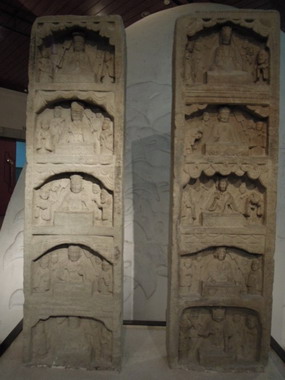
The statues of Yama-raja, created during Northern Song Dynasty, are of bluestone, with images on the front and lines on the back. Of the two statues, one is 170cm and the other 167cm in height. Both unearthed in Gongyi, Henan Province and preserved at the Henan Museum.
Link 2: Seated statue of Maitreya of Tang Dynasty
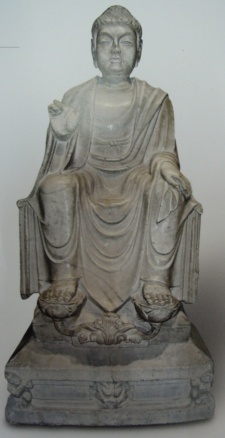
This is a statue of Maitreya carved on white marble, featuring rippling fleshy tuft on the head, full and mellow face, and silkworm lines on the neck. He wears underwear inside and kasaya with double droopy collars outside, light and fit, hanging down naturally between feet in a triangular form. With left hand resting on the left knee, the Buddha lifts his mutilated right hand, palm facing forward, and places his feet gracefully on the stemmed lotus throne. This style of seated statue of Maitreya was very popular in Tang Dynasty.
Notes:
① In Chapter 49 of the Pilgrimage to the West, which depicts the fight between Friar Sand and the Great King of Miraculous Response, the monster ridicules Friar Sand by saying that he must be a miller before because his weapon is a noodle-making pole. What appear on the stele correspond to the accounts of the novel.
② Collection of Line Drawings on Buddhist Art in Xinjiang, by Wang Jianlin, Xinjiang Juvenile Publishing House, 2006
③ The Acme of Dunhuang Art, by Xie Shengbao, 1993
Depicted in the following drawing are Bodhisattva Ksitigarbha and his two attendant guardians. Compare this drawing with Ksitigarbha carved in the stele’s fourth segment and guess the identity of the attendants besides him.

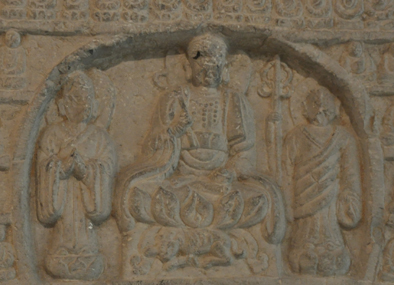
Your answer please, if you have any questions or answer, please fell free to send us email, we are waiting for your answer and participation, and your comments or answers will be highly appreciated. We will select and publicize the most appropriate answers and comments in the proper time.
Weekly Selection Email: meizhouyipin@chnmus.net
1. Garuda in Indian Buddhism Sutra and the Golden-winged Bird renowned in the Chinese folklore.
Known as the Golden-winged Bird in the Chinese translation, Garuda is one of the eight classes of brave divine beings in Buddhism and is said to be the mount of Visnu God. It is usually depicted as a warrior that has a bird head or wear a crest like cap and human body (see Fig.9).
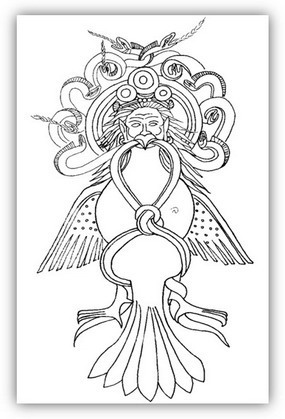
The size of Garuda on this stele is not much different from that of Tathagata Buddha. Apart from that, there appears more cordiality than respect towards the Buddha. Monkey King once says in Chapter 86 of the Pilgrimage to the West, “The Tathagata Buddha is the Honoured One who rules the world, and he sits below the Garuda bird.” The amusing combination of Tathagata Buddha and Garuda bird is a artistic representation of this Buddhism mythology existed in the Chinese version. Although differing, to some extent, from its Indian original, the Chinese version story does include the plot of the bird surrendering to the Buddha and becoming a guardian of Buddhism, which serves as a good example of the sinicization of Buddhism in the folklore and art.
2. The stele chooses the folklore version of the scripture-seeking story rather than the orthodox version popular during Wei and Jin Dynasties.
Among the Buddha-related image steles created during Wei and Jin Dynasties, not a few focus on Buddha stories, such as Birth of Buddha, Nine Dragons Bathing the Newborn Baby Buddha, and the Picture of Vimalakirti. This stele, too, chooses the folklore version of the scripture-seeking story as its theme. The story of Monk Sanzang travelling to the west under the escort of his disciple Monkey King for scriptures had spread during Tang Dynasty, after recreation by folk artisans over time it has become a legendary work of art. The earliest work should be the Poetic Tale on Master Tang Sanzang’s Pilgrimage to the West for Buddhist Scriptures published in the Southern Song Dynasty. In the Yulin Grotto mural paintings in Anxi County, Gansu Province there are pictures created during Song and Western Xia periods on the story of Monk Tang fetching scriptures (see Fig. 10), which, approximately more than three hundred years earlier than the publication of the Pilgrimage to the West during the Ming Dynasty, are the earliest of its kind existing across the country.③

This scripture-fetching themed picture is very rare in the Ming Dynasty’s image steles that have been exactly dated, which suggests the degree of the popularity this story had won among the people at that time.
The stele comprises of three parts – top, main body and seat. The figures on the stele include Sakyamuni, Maitreya and the Four Bodhisattvas – Avalokitesvara, Manjusri, Samantabhadra and Ksitigarbha. Also seen on the stele are the scenes of Monk Sanzang and his three disciples as they traveled to the west in quest of Buddhist scriptures in the famous Chinese mythological novel Pilgrimage to the West.
Sitting inside the niche on the top is the statue of Avalokiteśvara, with Sudhana on her right. According to the Buddhist Sutra, Sudhana paid a formal visit to Avalokitesvara in Mount Putuo, one of the Four Holy Buddhist Mountains, where he received advice and enlightenment from the Goddess; and he became her attendant afterwards. See Fig. 1.

The main body is divided into five segments from top to bottom, each with different engravings. In the centre of the top segment there is a curved niche which houses the Buddha, above whom is a beaked, man-like Garuda that has wings on both shoulders, and on either side of whom there is an Apsara, dressed in short coat and skirt, flying in opposite directions. On the sides of the Buddha we see two of his disciples, both with peach-shaped neck halo, standing on lotus throne waiting on him with a namaste gesture. See Fig. 2.
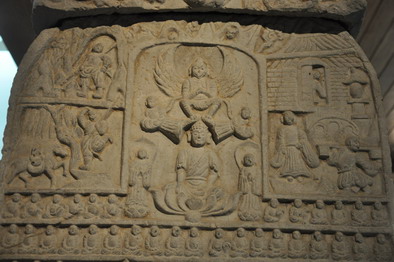
The right side of the niche is divided into two grids – the upper grid and the lower one. There’s a willow in the lower grid, on whose right side there is a white horse while on its left the vigorous Monkey King who, with the golden cudgel in his left hand, lifts his right hand poising himself to look into the distance. The figure in the upper grid, a Bhiksu who stands against a background of nimbus and big trees with a monster-hunting cane in his right hand ①, looks experienced and prudent and is believed to be Friar Sand, the third disciple of Monk Sanzang (see Fig. 3). On the left side of the niche we see a temple, with the gate half opened, located next to a Lamaist pagoda and an arch bridge, outside which there is a tall, brawny elder in kasaya, who is thought to be monk Sanzang, the hero of the pilgrimage. The figure under the arch bridge is a relative short Bhiksu whose face, with a big, protruding mouth, is apparently different the normal. Carrying the scripture boxes on shoulder, he is walking unhurriedly with his head turning sidewards, appearing quite amusing. He could be no one else but Pig, the second disciple of Monk Sanzang (see Fig. 4). Choosing the heroes of the folklore of Pilgrimage to the West as the subject is the highlight of this stele.

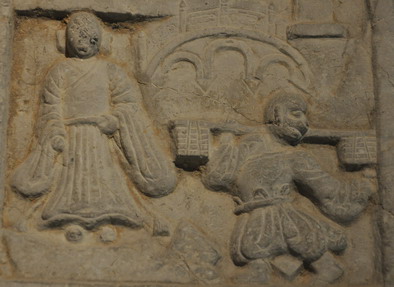
The second and fourth segments depict the Four Bodhisattvas – Avalokiteśvara, Manjusri, Samantabhadra and Ksitigarbha, all being well-known figures in China (see Fig. 5). The images in the middle of the second segment are Manjusri, Avalokitesvara and Samantabhadra (from left to right).
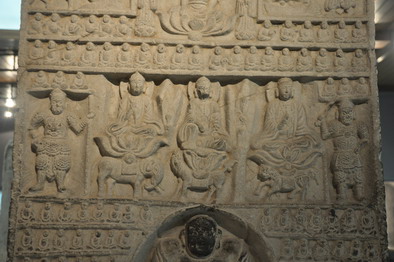
Carved in the middle of the third segment is an arch niche, whose deity Maitreya Buddha is seen sitting on the floor at ease, with bare chest and belly, beaming with good-nature, resting the left hand on his bag while holding a string of prayer beads in the right hand. See Fig. 6.
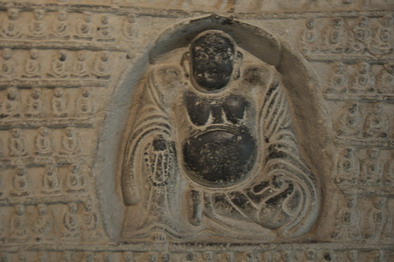
Similarly, there is also an arch niche in the middle of the forth segment the deity in which is Bodhisattva Ksitigarbha, who, wearing a monk’s cap, sits gravely on the lotus throne, holding the staff in the right hand and prayer beads in the left. There is a statue on either side of Ksitgarbha, both standing on lotus throne (see Fig. 7).
The carvings in the bottom segment include two rectangular niches inscribed between which are the three characters Thousand-Buddha Temple (see Fig. 8). In each of the two niches, there are five figures that, wearing official crown, dressed in loose-sleeved robe, stand on the lotus throne with the tablet being held before chest with both hands. They are the ten Yama-raja subordinated to Ksitgarbha. Designated by Sakyamuni as the Overlord of the Underworld, Ksitgarbha is the ruler of the hells in the Chinese folk belief, whose ten Yama-raja help him rule the hells. Naturally, their images are placed on the bottom of the stele.
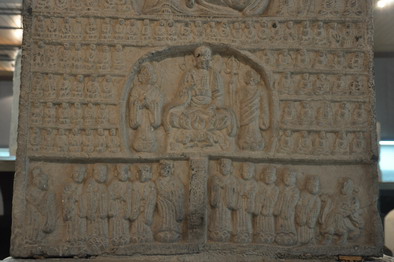

With a neat layout this stele is well arranged and appropriately structured. The images carved on the front face represent the artistic imagination rooted in the folks towards the heaven, earth and hell, respectively – the Buddha lives in the pure land in the west, towards where Monk Sanzang and his disciples travelled all the way in search of the true scriptures; Bodhisattvas are compassionate and benevolent figures who are ready to come down to earth to help people out of hardships, acting in Buddha’s name to ensure vice is punished and good supported and to preach Buddhism to all sentient beings; Maitreya was born from heaven down to the earth bringing people happiness and peace; no one being immortal, those who have committed sins will go to hell after death to be trialed by Yama-raja, King of Hell. Clearly, this stele is an artistic reproduction of the Chinese folk culture and Bodhisattva beliefs, a masterpiece of the secularization of Buddhism art.
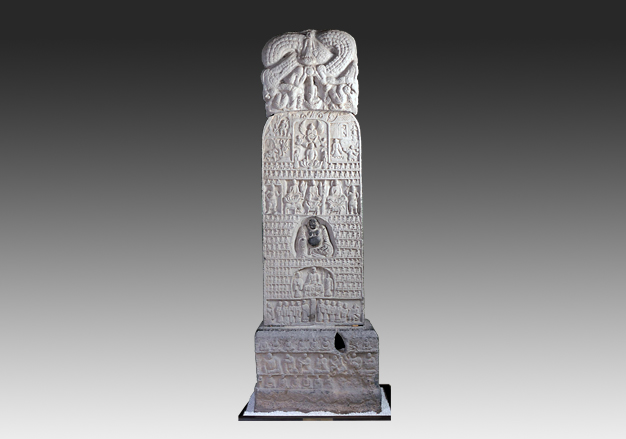

Tan Shuqin: Associate researcher of Henan Museum. Dedicated to the study of ancient stone carvings, particularly Han stone reliefs, steles and epitaphs, and ancient Buddhist sculptures.
Xu Xiaoli:Museologist of the Collections Administration Department of Henan Museum,devoted to the protection and research of the collections of calligraphy and paintings.
